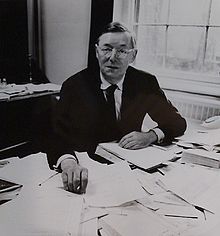John Pope-Hennessy
John Pope-Hennessy | |
|---|---|
 Pope-Hennessy at his desk. | |
| Born | John Wyndham Pope-Hennessy 13 December 1913 |
| Died | 31 October 1994 (aged 80) |
| Resting place | Cimitero degli Allori, Florence, Italy |
| Nationality | British |
| Alma mater | University of Oxford |
| Occupation | Art historian |
| Parents |
|
| Relatives | John Pope Hennessy (grandfather) James Pope-Hennessy (brother) |
Sir John Wyndham Pope-Hennessy CBE FBA FSA (13 December 1913 – 31 October 1994), was a British art historian. Pope-Hennessy was Director of the Victoria and Albert Museum between 1967 and 1973, and Director of the British Museum between 1974 and 1976. He was a scholar of Italian Renaissance art. Many of his writings, including the tripartite Introduction to Italian Sculpture, and his magnum opus, Donatello: Sculptor, are regarded as classics in the field.
Early years[]
Born into an Irish Catholic family in the Belgravia district of Central London, Pope-Hennesssy's father was Major-General Richard Pope-Hennessy, who was the son of the politician John Pope Hennessy. Pope Hennessy's mother was Dame Una Pope-Hennessy. He was the elder of two sons; his younger brother, James Pope-Hennessy was a noted writer.
Pope-Hennessy was educated at Downside School, a Catholic boarding school for boys, in Stratton-on-the-Fosse. He then went on to Balliol College at the University of Oxford, where he specialized in modern history. At Oxford, he was introduced by Logan Pearsall Smith, a family friend, to Kenneth Clark, who later became a mentor.
Upon graduation, Pope-Hennessy embarked his journeyman years by traveling in continental Europe and becoming acquainted with art collections, both public and private.
Career[]

Between 1955 and 1963, Pope-Hennessy's three-volume Introduction to Italian Sculpture was published, covering Gothic, Renaissance and High Renaissance and Baroque sculpture.[1] The following year, he was named Slade Professor of Fine Art at the University of Cambridge.
Pope-Hennessy served as the director of the Victoria and Albert Museum between 1967 and 1973, and then as director of the British Museum from 1974 until 1976. There, he was nicknamed by colleagues as "The Pope".[2]
Traumatized by the murder of his gay brother James in January 1974, Pope-Hennessy left the British Museum after only two years as director.[3] Initially, he went to Tuscany, but was enticed by an offer from the Metropolitan Museum of Art to head its department of European painting, and moved to New York City. He combined this curatorial post with a professorship at New York University's Institute of Fine Arts. In 1986, Philippe de Montebello, director of the Metropolitan Museum of Art, created the John Pope-Hennessy Curatorship of European Paintings.[4]
Pope-Hennessy was also one of many scholars to serve on the board of Save Venice Inc., a non-profit organization dedicated to the conservation and preservation of Venetian cultural heritage.
Death and legacy[]

Pope-Hennessy retired at the age of seventy-five and moved permanently to Florence with his lover, Michael Mallon, and resided at Palazzo Canigiani, where he died five years later.[5] Pope-Hennessy is buried in the Cimitero degli Allori in Florence. His gravestone includes a quote from the First Epistle to the Corinthians in the Bible.
Selected works[]
- The Drawings of Domenichino in the Collection of His Majesty the King at Windsor Castle, 1948
- A Lecture on Nicholas Hilliard, 1949
- Introduction to Italian Sculpture (3 vols.), 1955–1963
- Donatello: Sculptor, 1993
- Essays on Italian Sculpture, 1968
- Catalogue of Italian Sculpture in the Victoria and Albert Museum (3 vols.), 1964
See also[]
References[]
External links[]
- Finding aid for the John Pope-Hennessy Papers at the Getty Research Institute.
- 1913 births
- 1994 deaths
- British people of Irish descent
- British Roman Catholics
- People from Belgravia
- People educated at Downside School
- Alumni of Balliol College, Oxford
- British art historians
- British curators
- Directors of the Victoria and Albert Museum
- Directors of the British Museum
- People associated with the Metropolitan Museum of Art
- Slade Professors of Fine Art (University of Oxford)
- Academics of the University of Cambridge
- New York University Institute of Fine Arts faculty
- Commanders of the Order of the British Empire
- Fellows of the British Academy
- Fellows of the Society of Antiquaries of London
- British expatriate academics in the United States
- British expatriates in Italy
- LGBT people from England